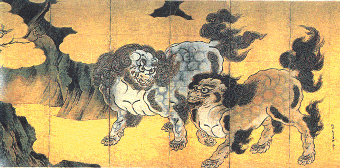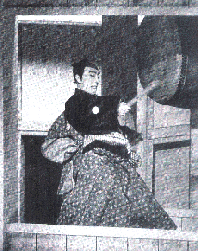
DECEMBER
under construction
KABUKI-ZA
Evening Programme
Sakai no Taiko
Renjishi
Ume Goyomi
KABUKI-ZA
Click here for Matinee Programme
KABUKI-ZA
Matinee Programme
「唐獅子図屏風」狩野永徳筆 桃山時代
1). "Sakai no Taiko".

Artist-Kunindo II "Sakai no Taiko". Ichikawa Danjuro IX/Ichikawa Ennosuke I.
1892 5月 Kabuki-za.
This play was written by Kawatake Mokuami in 1873, and is representative of a category of works called "Katsureki", "Living History" plays, which sought to depict past events as accurately as possible. Strict attention was paid to the correct way of speaking, as well as to proper behaviour, costume, make-up and character based on the then current research. The actor who championed these "Katsureki" plays was Ichikawa Danjuro IX, for whom the part of Saemon was originally written, and the actor playing that role this month is Danjuro XII. "Sakai no Taiko" has rarely been performed since Danjuro IX's time, though he himself thought enough of it to include it as one of his "Shin Kabuki Juhachiban", (yet another collection of no less than 32 favourite plays, many of which are included in the "Katsureki" genre. The term "juhachiban" actually means "eighteen", but here is used more generally to indicate one actor's particular selection of favourites.) "Sakai no Taiko" was also liked well enough for Danjuro XI to revive it at least three times, but after that it has only been seen once more when the current Koshiro IX played the role of Saemon in 1982. Though "Katsureki" was a very important development from an historical viewpoint, today many regard it as a phenomenon peculiar to the Meiji period and most of the plays are now felt to be boring. Personally, I think "Sakai no Taiko" is NOT a boring play, but this month's production doesn't do quite enough to bring out its best points.

酒井左衛門 11代目市川団十郎
It is surely extremely difficult to act because the motivation of the characters is not necessarily expressed in the dialogue. In particular, Ieyasu says and does one thing but secretly means something completely different. Saemon too seems totally incompetent at his job and yet is the great hero of the play! It is what happens beneath the surface that's so important and, while the actors have to be very subtle in their portrayals, if they're not careful the audience simply won't know what's going on.
It's essential to understand the background. It is the end of winter in the year 1572 and the country is in turmoil. Several warlords are taking advantage of this chaos to gain ever greater tracts of land for themselves to add to their power. As the play begins, it is Takeda Shingen who is attacking Tokugawa Ieyasu, (then, still under the protection of lord Oda Nobunaga). The action takes place at Ieyasu's stronghold, the small castle of Hamamatsu, and he himself has just returned from an unsuccessful battle that morning at Mikata-ga-hara. All fear for their lives, yet Ieyasu himself, along with one of his loyal retainers, Sakai no Saemon, both seem unconcerned. When the other men went off to battle that day Saemon was left in charge of the castle, and he even appears to have drunk himself into a stupor.
The whole play hangs on the idea of a bluff. Ieyasu knows full well that he and his followers are in terrible trouble and may well lose their lives. His apparent lack of concern is perhaps to comfort and encourage his people, whereas infact He's about to make one last-ditch attempt to save their lives. If that fails they are all lost. Despite being greatly outnumbered and though the enemy has advanced right up to the castle outskirts, he decides to leave the front gate wide open and to light bonfires for the enemy to see. Naturally, everyone thinks this idea insane and a valiant retainer called Torii Hikoemon even considers taking matters into his own hands. But he is stopped by Sakai Saemon. Saemon is drunk, yet he is the only one who seems to understand his lord's intentions.
2). "Renjishi".

「連獅子」森義利画
This is yet another work by Kawatake Mokuami, but in complete contrast to "Sakai no Taiko", this is a dance performed to Nagauta music. It was first danced by actors on the Kabuki stage in 1872, though the central section, "Shuron", wasn't added until 1901. This dance has come to be staged often recently and is popular for its spectacular ending as well as for the opportunity to see a father and son combination of actors in the leading roles. This month we see Kataoka Takao and his son, Takataro. In January, Takao will change his name to Nizaemon XV and so this dance is the last performance he'll give under his old name. This version of "Renjishi" also differs from what we normally see in that its choreography is by Ichiyama Shichijuro.
The theme of "Renjishi" stays close to that of the No play "Shakkyo", and it is classified as a "matsubame" dance. That is, a dance that's performed before the symbolic backdrop of a large pine tree flanked by bamboo which is copied from the No stage. This scenery has no connection with the dance's content. The first section features a pair of Kyogen actors who come to dance the story of the shishi parent and cub. The actors each carry a wooden mask of a shishi head, one with white hair representing the parent shishi and the other with red hair to represent its child. A "shishi" is a mythological lion-like animal said to be the king of beasts and always associated with the Buddhist deity Monju. For this reason, any portrayal of the shishi should not only bring out its wild, beastial nature, but also a sense of dignity and authority that goes with this divine status. The shishi is in many ways a spiritual creature.
The dance is set on a holy mountain in China called Seiryozan, among the towering peaks of which there is a miraculous stone bridge spanning a deep ravine. The bridge is a divine manifestation for on the other side is the Buddhist paradise... the land where the deity Monju dwells. The lyrics here are especially magnificent and describe the scenery with such graphic power that one feels truly awestruck. Through the dancers' movements too, the scenery should come alive before our eyes. The highlight of this first section depicts the severe physical training the shishi cub must undergo at the hand of its parent. In order to foster courage and strength the parent kicks its young over the edge of the ravine and must wait anxiously to see if the cub can climb back up again. This is said to be a great test of the actor's abilities for he must portray fatherly love as well as a strict sense of discipline. In my own experience, the actor who excelled at this role was the late Nakamura Kanzaburo XVII when he danced "Renjishi" with his son, Kankuro. The pathos and dignity which he brought out will be hard for any other actor to equal. It is in this respect particularly that I dislike the Ichiyama school choreography, for the parent shishi seems to have altogether too much to do at this point. It is another case of "less would be more". With the usual choreography one has a sense of great stillness that makes the emotion more profound. The shishi cub also has some strange movements to perform which are, frankly, ugly: as the cub bounds up the side of the ravine to be reunited with its parent the actor kicks his feet up behind him almost like a prancing horse! Of course, the cub is supposed to exude all the energy of youth but this is overdoing it.
After the two Kyogen actors withdraw down the hanamichi, we begin the second section of the dance which is a comic interlude called "Shuron", "Religious Debate". This is patterned after the comic plays of the Kyogen theatre which are normally seen in the middle of No plays. In this case, two priests who are on a pilgrimage to Mt. Seiryo meet and begin arguing when they discover that they're from different Buddhist sects. Eventually, both become frightened by the darkening skies and by the prospect of coming across the fierce shishi, and they run back down the mountain in a panic.

Artist-Gototei Kunisada. Dance-"Shakkyo" from "Hana Kyodai Nenju Gyoji" Ichimura-za, 1840 3月. Ichikawa Uzaemon XII Nakamura Utaemon IV.
To prepare us for the final scene, the Nagauta musicians then begin a section of "Ozatsuma" music which is wonderful in its evocation of the grand mountain scenery. The leading shamisen player, (Kineya Gosaburo), is especially good. Then, and much earlier than in the usual version of "Renjishi", the spirits of the shishi pair enter. There is a short section of slow and gentle drum beats called "tsuyu", "dew", representing single drops of dew falling from the mountain peonies, and though this section is usually heard before the shishi enter, in this month's version the shishi come in while this section is being played. This is a pity, as we miss the "quiet before the storm" effect that we usually have here. The shishi appear wearing the gorgeous brocade costumes that copy those of No and also have the large trailing wigs made from real yak hair. Their fianl dance is one of celebration which also expresses the power of these "kings of beasts". However, yet again there are some strange foot movements in this Ichiyama school choreography which don't seem in keeping with the animal's elevated status. In particular, the shuffling movements of the parent shishi as it waits for its cub to reappear on the hanamichi reminds one of the drunken wine sprite in "Shojo" which doesn't seem very appropriate here.
3). "Ume Goyomi".
This is a long play written by Kimura Kinka, but based on a novel by Tamenaga Shunsui. The Kabuki play was first performed in 1927, but in recent years it's become a popular vehicle for the combined talents of Bando Tamasaburo and Nakamura Kankuro in the leading roles of the two geisha, Adakichi and Yonehachi. This month they play them again, and are joined in the production by Ichikawa Danjuro as the handsome Tanjiro, Sawamura Tojuro as another geisha, Masaji and by Ichikawa Kamejiro as Tanjiro's young fiancee, Ocho.
The main story concerns the rivalry between Adakichi and Yonehachi for the love of Tanjiro. This situation gives rise to a number of highly entertaining scenes when, for example, in a fit of jealous rage Yonehachi tramples on the brand new haori coat that Adakichi has just presented to Tanjiro, or when, by way of revenge, Adakichi manages to beat Yonehachi over the head with a geta clog in an amusing parody from the famous highlight from "Kagamiyama Kokyo no Nishiki-e". Both Tamasaburo and Kankuro are ideal for their parts and, in contrast to the role of Oichi-no-kata in "Momoku Monogatari" which he played earlier in the day, Tamasaburo is here the personification of 19th century "chic". The geisha of the Fukagawa district of Edo, (the old name for Tokyo), where this tale is set, were famous for their stylishness and cheeky pride and Tamasaburo plays this to perfection. It comes through not only in the way he looks and speaks, but also in superb little touches of acting as, for example, when Adakichi must remove the threads from the new haori before Tanjiro can try it on. This involves miming the actions and Tamasaburo does this so accurately and convincingly that the audience usually can't help but laugh with pleasure. Kankuro too, is excellent as the slightly coarser geisha Yonehachi and demonstrates his abilities in female roles beautifully. As a pair the two actors are very well balanced.
Back




